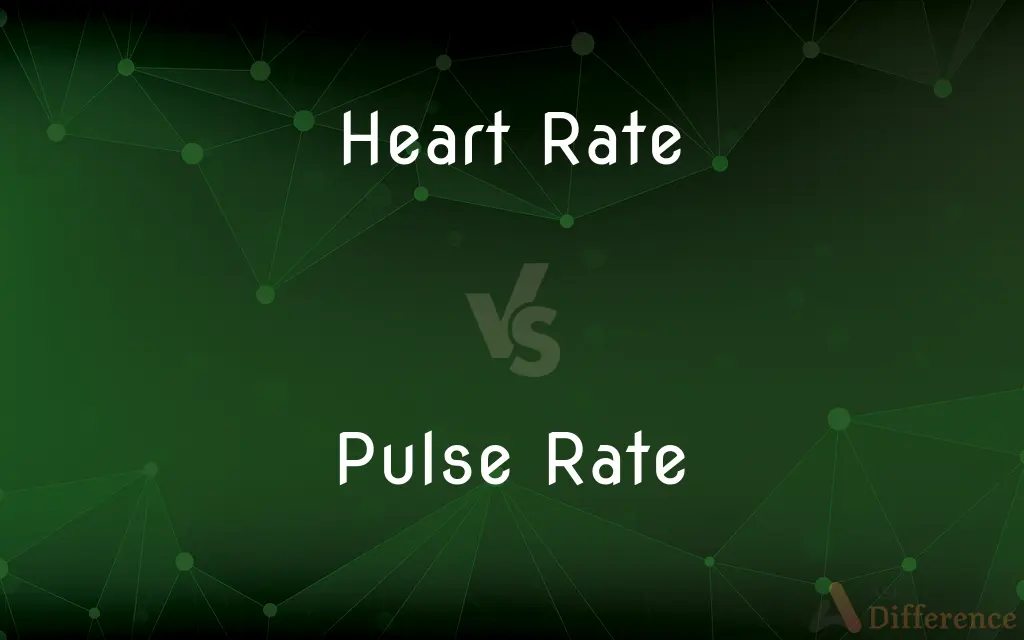Heart Rate vs. Pulse Rate — What's the Difference?
By Tayyaba Rehman & Fiza Rafique — Published on February 7, 2024

Difference Between Heart Rate and Pulse Rate
Table of Contents
ADVERTISEMENT
Key Differences
Heart rate represents the frequency of a complete heartbeat cycle per minute, indicating how often the heart contracts to pump blood. Pulse rate, on the other hand, is the physical sensation of the heartbeat felt at various pulse points in the body, such as the wrist or neck.
The measurement of heart rate is a direct reflection of the heart's working condition and rhythm. In contrast, pulse rate is essentially the rate at which these heartbeats are felt under the skin at arterial sites, providing an indirect measure of heart activity.
Heart rate is crucial in assessing the overall cardiovascular health and is influenced by factors like physical activity, emotions, and health conditions. Pulse rate, while often equal to the heart rate, can differ if the heartbeat is too weak to produce a palpable pulse, or in certain medical conditions.
Heart rate can be measured using medical equipment like electrocardiograms, which record the electrical activity of the heart. Pulse rate is typically measured manually, where one feels the pulse at various points on the body, or using pulse monitors that sense blood flow changes.
Understanding heart rate is essential in medical diagnostics for detecting heart conditions, whereas monitoring pulse rate is often used for quick, everyday health checks, such as during exercise or in first aid situations.
ADVERTISEMENT
Comparison Chart
Word Class
Noun
Noun
Plural Form
Heart rates
Pulse rates
Adjective Form
Cardiac (as in cardiac rhythm)
Pulsatile (as in pulsatile flow)
Use in Sentences
Often used as a subject or object (e.g., "Heart rate increased")
Commonly used as an object (e.g., "Check your pulse rate")
Associated Verbs
Beat, fluctuate (e.g., "Heart rate fluctuates during exercise")
Feel, measure (e.g., "Measure the pulse rate at the wrist")
Compare with Definitions
Heart Rate
The frequency at which the heart completes one pumping cycle.
He monitored his heart rate while jogging.
Pulse Rate
A physical indication of the heart rate at various body sites.
His pulse rate was measured at his wrist.
Heart Rate
A measure of cardiac activity.
The doctor checked his heart rate during the physical exam.
Pulse Rate
The number of times the heartbeat is felt at the pulse points per minute.
She felt her pulse rate quicken with excitement.
Heart Rate
The speed of the heartbeat measured by the number of contractions.
The athlete's heart rate was exceptionally low due to conditioning.
Pulse Rate
A measure of heartbeat as observed through the vascular system.
During the exam, the doctor noted a regular pulse rate.
Heart Rate
A vital sign indicating the rhythm and strength of the heart.
Stress can cause an elevated heart rate.
Pulse Rate
The rate at which arterial pulsations occur.
The nurse checked the patient's pulse rate.
Heart Rate
The number of heartbeats per minute.
Her heart rate increased during the sprint.
Pulse Rate
The tactile count of heartbeats per minute at an arterial site.
He learned to measure his pulse rate during workouts.
Common Curiosities
How fast is USB 1.0?
USB 1.0 supports data transfer rates up to 12 Mbps.
Can USB 1.0 devices work in USB 2.0 ports?
Yes, USB 1.0 devices are backward compatible with USB 2.0 ports, but they will operate at USB 1.0 speeds.
What advantages does USB 2.0 offer over USB 1.0?
USB 2.0 provides significantly higher data transfer rates, better power management, and supports a wider range of high-bandwidth devices.
What is USB 1.0?
USB 1.0 is the first version of the Universal Serial Bus standard, introduced to simplify connections between devices and computers.
What is USB 2.0?
USB 2.0 is an upgraded version of USB, offering higher data transfer rates and improved functionalities over USB 1.0.
How fast is USB 2.0?
USB 2.0 can achieve data transfer rates up to 480 Mbps.
Are USB 2.0 devices compatible with USB 1.0 ports?
USB 2.0 devices can connect to USB 1.0 ports but will function at the slower USB 1.0 speed.
What type of devices used USB 1.0?
USB 1.0 was commonly used for low-bandwidth devices like keyboards, mice, and simple printers.
Is there a visual difference between USB 1.0 and USB 2.0 connectors?
Physically, USB 1.0 and USB 2.0 connectors are the same, but USB 2.0 ports/devices may be labeled or color-coded to differentiate.
Is USB 2.0 still relevant today?
While newer standards like USB 3.0 and beyond offer even faster speeds, USB 2.0 remains relevant and widely used for many peripherals.
Do I need special drivers for USB 2.0?
Most modern operating systems natively support USB 2.0, so special drivers are typically not required.
Was USB 1.0 widely adopted?
USB 1.0 was quickly adopted for its simplicity and versatility but was soon overshadowed by USB 2.0 due to speed limitations.
Why was USB 2.0 developed?
USB 2.0 was developed to address the need for faster data transfer rates and better performance with a growing range of devices.
Can USB 2.0 be used for video devices?
Yes, USB 2.0's high data transfer rate makes it suitable for bandwidth-intensive devices like webcams and video capture devices.
How does power management differ between USB 1.0 and USB 2.0?
USB 2.0 offers enhanced power management features, allowing for more efficient charging and power distribution among connected devices.
Share Your Discovery

Previous Comparison
Liver vs. Lungs
Next Comparison
.40 S&W vs. .45 ACPAuthor Spotlight
Written by
Tayyaba RehmanTayyaba Rehman is a distinguished writer, currently serving as a primary contributor to askdifference.com. As a researcher in semantics and etymology, Tayyaba's passion for the complexity of languages and their distinctions has found a perfect home on the platform. Tayyaba delves into the intricacies of language, distinguishing between commonly confused words and phrases, thereby providing clarity for readers worldwide.
Co-written by
Fiza RafiqueFiza Rafique is a skilled content writer at AskDifference.com, where she meticulously refines and enhances written pieces. Drawing from her vast editorial expertise, Fiza ensures clarity, accuracy, and precision in every article. Passionate about language, she continually seeks to elevate the quality of content for readers worldwide.
















































